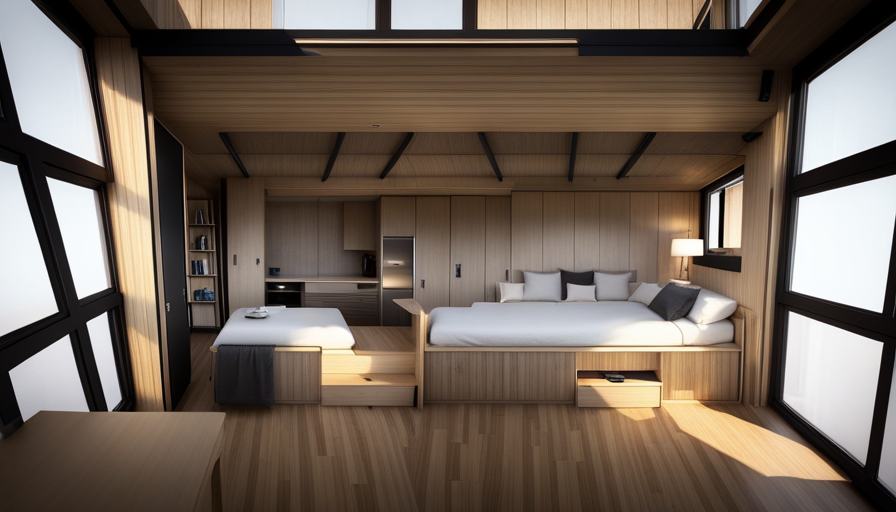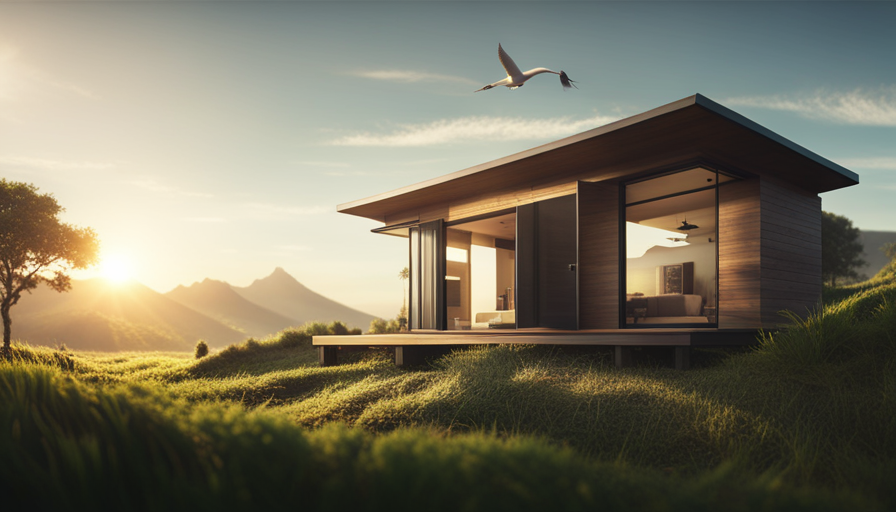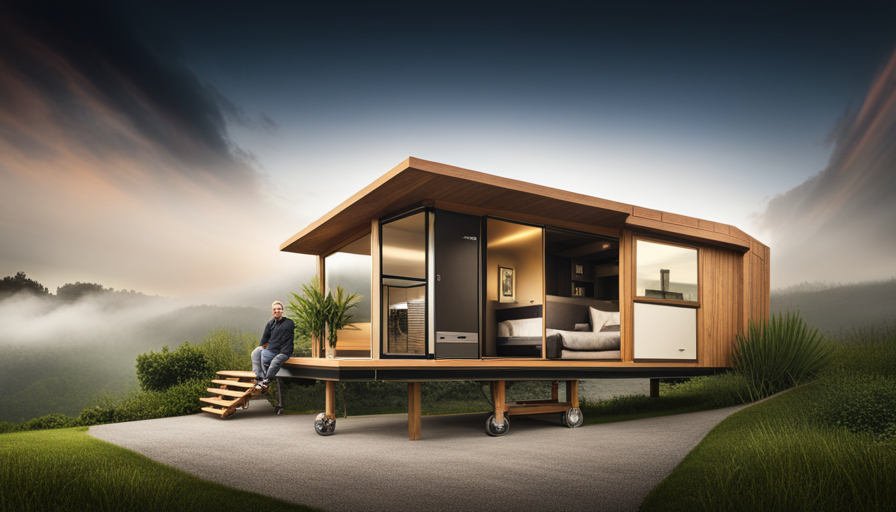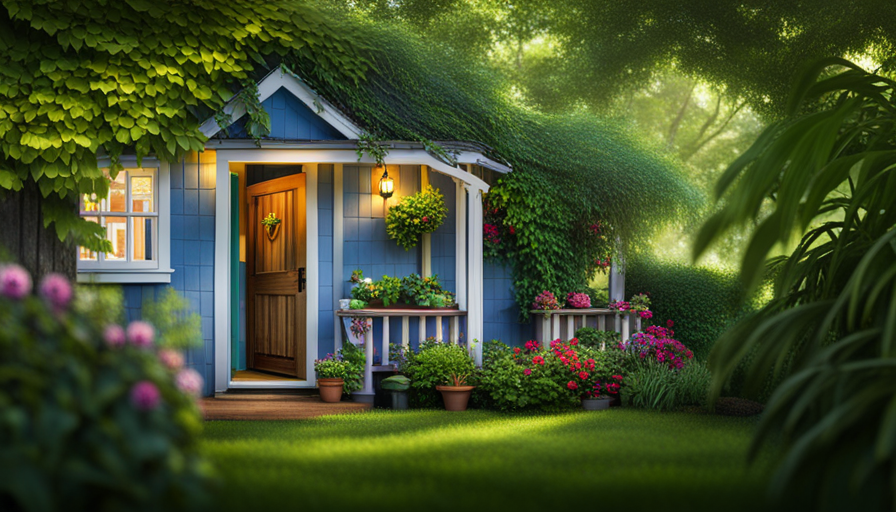Were you aware that the typical American consumes between 80-100 gallons of water daily? This is a considerable quantity, particularly when reflecting on the reduced space and resources commonly associated with tiny homes.
So, how does a tiny house get water?
In this article, I will delve into the various methods and solutions that tiny house owners employ to ensure a steady supply of water. From traditional plumbing connections to off-grid water solutions, there are several options available to meet the unique needs of tiny house living.
I will explore rainwater harvesting, a method that allows homeowners to collect and store rainwater for everyday use. Greywater recycling is another technique that involves treating and reusing water from sinks, showers, and laundry. Composting toilets offer a sustainable alternative to traditional flush toilets, while portable water tanks provide mobility and flexibility.
Additionally, I will discuss water filtration and purification systems, as well as the importance of winterizing water systems in cold climates. Finally, I will touch upon maintenance and troubleshooting tips to ensure a smooth and efficient water supply.
Join me on this journey as we explore the fascinating world of how tiny houses get water.
Key Takeaways
- Tiny houses have limited space and resources, so various methods and solutions are utilized for water supply.
- These methods include rainwater harvesting, greywater recycling, composting toilets, and portable water tanks.
- Proper maintenance and troubleshooting are necessary for efficient water supply in tiny houses.
- Winterizing water systems in cold climates is important to prevent frozen pipes and ensure continuous access to safe drinking water.
Traditional Plumbing Connections
So, how exactly does a tiny house manage to get water? Well, it’s all about the traditional plumbing connections. In a tiny house, the plumbing system is similar to that of a regular house, just on a smaller scale. It consists of pipes, valves, and fixtures that allow water to flow in and out of the house.
To ensure traditional plumbing maintenance in a tiny house, it’s crucial to have a water supply connection. This typically involves connecting the tiny house to a municipal water source or a well. The connection is made using a water line that runs from the source to the tiny house. It’s important to install pressure regulators to control the water pressure, as excessive pressure can cause damage to the plumbing system.
Inside the tiny house, the water is distributed through a network of pipes. These pipes are usually made of copper or PEX (cross-linked polyethylene) and are connected to fixtures such as faucets, showers, and toilets. To ensure efficient water flow, it’s essential to properly size the pipes and use the correct fittings.
Now that we understand how traditional plumbing connections work in a tiny house, let’s delve into another water source option: rainwater harvesting. This method allows tiny house owners to collect and utilize rainwater for various purposes.
Rainwater Harvesting
Rainwater harvesting allows these compact homes to efficiently collect and utilize precipitation. This sustainable method of water collection involves capturing rainwater from the roof of the tiny house and directing it into a storage system for later use.
The process begins with the installation of gutters and downspouts, which collect the rainwater as it falls. The collected rainwater is then channeled into a filtration system to remove debris and impurities. Once filtered, the water is stored in a specially designed tank or cistern for future use. These tanks are typically made from food-grade materials to ensure the water remains safe for consumption.
Rainwater collection systems in tiny houses can vary in size and complexity depending on the needs of the occupants. Some systems may be as simple as a barrel positioned under a downspout, while others may incorporate larger underground tanks or multiple storage containers.
The collected rainwater can be used for a variety of purposes, including washing dishes, flushing toilets, or even providing water for showers.
Transitioning into the subsequent section about greywater recycling, it is important to note that rainwater harvesting is just one method of water conservation in tiny houses. Another sustainable practice is the recycling of greywater, which involves reusing water from sinks, showers, and laundry for irrigation or toilet flushing.
Greywater Recycling
Transitioning to greywater recycling, occupants of compact homes can repurpose water from sinks, showers, and laundry for irrigation or toilet flushing, further contributing to sustainable water usage. Greywater treatment is an essential part of this process to ensure that the recycled water is safe for reuse.
Here’s how it works:
-
Collection: Greywater is collected from the various sources mentioned earlier, excluding water from toilets and kitchen sinks which may contain contaminants.
-
Filtration: The collected greywater goes through a filtration system to remove larger particles, such as hair and lint. This helps prevent clogging in the pipes and irrigation system.
-
Biological treatment: After filtration, the greywater undergoes biological treatment. This involves the use of bacteria and other microorganisms to break down organic matter and remove harmful pathogens.
-
Disinfection: To ensure the water is safe for reuse, it is disinfected using methods like UV light or chlorine. This kills any remaining bacteria and viruses, making the water suitable for irrigation or flushing toilets.
Transitioning to the subsequent section about composting toilets, it’s important to consider sustainable waste management in compact homes.
Composting Toilets
When it comes to living in a tiny house, one of the key considerations is how to manage waste without access to traditional plumbing systems. This is where a waterless toilet system, also known as a composting toilet, comes in handy. These toilets use a natural process of decomposition to break down waste into compost, eliminating the need for water and sewer connections.
Additionally, managing waste and odor in a composting toilet involves a careful balance of adding carbon-rich materials like sawdust or coconut coir to absorb moisture and neutralize odors, as well as regularly emptying and maintaining the composting chamber.
Using a Waterless Toilet System
In the miraculous world of tiny house living, even the tiniest of abodes can possess a remarkable waterless toilet system that defies traditional plumbing methods. Waterless toilet systems offer numerous benefits, making them an attractive option for those seeking sustainable and low-maintenance alternatives.
These systems eliminate the need for water usage, minimizing environmental impact and reducing water bills. Additionally, they provide DIY enthusiasts with various options to create their own customized waterless toilet system, allowing for flexibility and creativity in design.
Managing waste and odor in a composting toilet is the next crucial step in maintaining a hygienic and odor-free living space. By implementing proper waste management techniques and utilizing odor control methods such as ventilation, carbon filters, and natural additives, one can effectively manage waste and eliminate any unpleasant odors.
These strategies ensure a clean and comfortable living environment while taking advantage of the benefits of composting toilets.
Managing Waste and Odor in a Composting Toilet
To effectively manage waste and eliminate unpleasant odors in a composting toilet, you’ll need to implement proper waste management techniques and utilize odor control methods.
One crucial aspect is ventilation. It helps remove moisture and odors from the toilet area, keeping your tiny house fresh-smelling. It is recommended to install a fan or vent system that directs air outside the house.
Carbon filters can be added to the ventilation system to further reduce odors. They trap and neutralize odors, enhancing the effectiveness of the system.
In addition to ventilation and carbon filters, using natural additives can help control odors and absorb moisture in the composting chamber. Sawdust or coconut coir are popular choices for this purpose.
Regular maintenance of the composting toilet is essential for proper functioning and odor control. This includes emptying and cleaning the composting chamber.
Now, let’s transition to the next section about portable water tanks and discuss the importance of having a reliable water source in a tiny house.
Portable Water Tanks
Portable water tanks provide a practical solution for tiny houses to access and store water. When living in a small space, it is crucial to have efficient and reliable water supply options. These tanks can hold a significant amount of water and can be easily transported and connected to a tiny house’s plumbing system.
To illustrate the benefits of portable water tanks, I have created a table showcasing different options available in the market:
| Option | Capacity (gallons) | Material | Weight (lbs) | Price ($) |
|---|---|---|---|---|
| Tank A | 30 | Plastic | 25 | 100 |
| Tank B | 50 | Stainless Steel | 40 | 150 |
| Tank C | 100 | Polyethylene | 70 | 200 |
| Tank D | 150 | Fiberglass | 100 | 300 |
| Tank E | 200 | Polypropylene | 120 | 400 |
These portable water tanks offer a range of options to suit different needs and budgets. After securing a reliable water supply, it is important to conserve water in a tiny house. In the next section, we will explore water conservation techniques that can be implemented to ensure sustainable water usage.
[Water conservation techniques] can help maximize the use of the available water resources while minimizing waste.Water Conservation Techniques
Implementing water conservation techniques can help maximize the use of available water resources while minimizing waste in a tiny home. Here are four water-saving tips that can be applied in an eco-friendly tiny house:
-
Install low-flow fixtures: Replace traditional faucets and showerheads with low-flow alternatives to reduce water consumption. These fixtures restrict the flow of water without compromising functionality.
-
Harvest rainwater: Set up a rainwater collection system to capture and store rainwater for various uses such as flushing toilets, watering plants, or doing laundry. This not only reduces reliance on the main water supply but also utilizes a sustainable water source.
-
Greywater recycling: Treat and reuse greywater from sinks, showers, and washing machines for irrigation purposes. By diverting this water from the sewage system, you can significantly reduce water wastage.
-
Insulate pipes: Insulating water pipes helps prevent heat loss, ensuring hot water reaches the desired location more quickly. This reduces the need to let water run to achieve the desired temperature, saving both water and energy.
Implementing these water conservation techniques in a tiny house promotes sustainability and efficient resource utilization. Transitioning into the subsequent section about ‘off-grid water solutions,’ it’s crucial to explore additional methods for obtaining water independently.
Off-Grid Water Solutions
When it comes to off-grid water solutions for a tiny house, there are two key points to consider. One is using solar-powered water pumps, which are a great option for those who want a sustainable and energy-efficient way to pump water. These pumps use solar energy to power the pump, eliminating the need for electricity or fuel.
The other point is utilizing gravity-fed systems. Gravity-fed systems make use of the natural force of gravity to supply water to the tiny house. This is done by placing water storage tanks at a higher elevation than the house. The water then flows down through pipes, providing a constant and reliable water source.
Using Solar-Powered Water Pumps
Solar-powered water pumps provide a sustainable solution for tiny houses to access water. These pumps utilize solar energy to power the pumping mechanism, allowing for a consistent and reliable water supply.
With solar powered irrigation systems, tiny house owners can effectively water their gardens and plants without relying on traditional electricity sources. These pumps are designed to be energy-efficient, utilizing solar panels to convert sunlight into electricity and store it in batteries for later use. This ensures that water can be accessed even during periods of low sunlight.
By incorporating solar-powered water pumps into their off-grid water systems, tiny house owners can achieve a sustainable water sourcing solution that minimizes their environmental impact.
In the subsequent section, I will discuss how tiny houses can utilize gravity-fed systems to further enhance their water supply.
Utilizing Gravity-Fed Systems
In my previous discussion on using solar-powered water pumps for tiny houses, I highlighted the benefits of harnessing renewable energy to pump water. Now, let’s delve into another efficient method: utilizing gravity-fed systems.
These systems rely on the natural force of gravity to provide water pressure for various needs in a tiny house. By positioning water storage tanks at a higher elevation than the fixtures, water flows down through pipes, creating sufficient pressure for tasks such as showering, washing dishes, or flushing toilets.
Gravity-fed irrigation systems also work in a similar way, allowing water to flow through channels to water plants and crops. This method is not only cost-effective but also eco-friendly, as it doesn’t require any electricity or additional equipment.
Moving forward, let’s explore how water filtration and purification play a crucial role in ensuring a clean and safe water supply for tiny houses.
Water Filtration and Purification
When it comes to choosing the right water filtration system for my tiny house, I need to consider several factors.
I need to assess the quality of the water source, the specific contaminants present, and the flow rate required.
Additionally, I must ensure that the filtration system I choose is capable of removing bacteria, viruses, and other harmful pathogens to ensure safe and clean drinking water.
With careful consideration and proper research, I can find the perfect water filtration system for my needs.
Choosing the Right Water Filtration System
Water filtration systems for tiny houses are like the unsung heroes, quietly ensuring that the purest drops of water flow through the home’s faucets. When choosing water storage and treatment options for a tiny house, it’s essential to consider the specific needs and limitations of the space.
Here are four key factors to consider:
-
Space: Since tiny houses have limited space, it’s crucial to select a filtration system that’s compact and can fit within the available area.
-
Efficiency: Look for a filtration system that can effectively remove contaminants such as sediment, bacteria, and chemicals, ensuring the water’s safe for consumption.
-
Maintenance: Consider the ease of maintenance for the chosen system. Systems with replaceable filters or cartridges are convenient and cost-effective in the long run.
-
Water Source: Assess the quality of the water source and select a filtration system that targets specific contaminants present in the water supply.
Choosing the right water filtration system ensures safe and clean drinking water, ensuring a healthy and comfortable living environment in a tiny house.
Ensuring Safe and Clean Drinking Water
With a reliable water filtration system, you can savor every sip of refreshing, crystal-clear water in your tiny oasis. Ensuring safe and clean drinking water is essential when living in a tiny house.
There are various clean water sources available for tiny homes, such as municipal water supply, well water, or rainwater harvesting. It’s important to choose the right water storage options based on your needs and available space. Some common options include water tanks, containers, or even built-in storage systems. These storage options should be properly sealed and insulated to prevent contamination and freezing during colder months.
Winterizing water systems is crucial to ensure continuous access to safe drinking water. By following proper maintenance procedures and insulating pipes, you can enjoy clean water even during the harshest winter conditions.
Transitioning into the subsequent section, let’s explore how to winterize your tiny house water systems.
Winterizing Water Systems
To ensure the tiny house water systems are well-prepared for the winter season, it’s crucial to implement effective insulation techniques and regularly maintain the plumbing.
Winterizing plumbing systems is essential to prevent frozen pipes, which can lead to costly repairs and potential water damage. Insulating the pipes with foam sleeves or heat tape can help protect them from freezing temperatures. It’s also important to insulate any exposed areas, such as crawl spaces or cabinets, where pipes are located. Additionally, sealing any gaps or cracks in the walls can prevent cold air from infiltrating and affecting the water lines.
Regular maintenance is key to ensuring the water systems remain in optimal condition throughout the winter. This includes checking for any leaks or drips and promptly repairing them. Drain and disconnect any outdoor hoses to prevent water from freezing and causing damage to the hose and the connected pipes. It’s also advisable to keep the tiny house heated above freezing temperatures to further safeguard the water systems.
Winterizing the plumbing systems in a tiny house is vital to prevent frozen pipes and potential water damage. By implementing insulation techniques, regularly maintaining the plumbing, and taking necessary precautions, the water systems can withstand the winter season.
In the next section about maintenance and troubleshooting, we’ll explore additional steps to ensure the proper functioning of the tiny house water systems.
Maintenance and Troubleshooting
Maintaining and troubleshooting the water systems in a tiny house is like keeping a high-performance race car in top shape – it requires constant attention and fine-tuning. To ensure the water systems in your tiny house function properly, here are some maintenance tips and common issues to be aware of:
Regularly inspect for leaks: Check all connections, pipes, and faucets for any signs of leakage. Even a small leak can cause significant damage over time, so it’s crucial to address them promptly.
Clean and sanitize the water tank: Tiny houses often have limited water storage, so it’s essential to keep the tank clean and free from bacteria or sediment buildup. Regularly flush and sanitize the tank using a bleach solution or specialized water tank cleaner.
Check the water pump: The water pump is a critical component of the water system. Ensure it’s functioning correctly by listening for any unusual noises or vibrations. Also, check the pump’s pressure and adjust it if necessary.
Common issues that may arise with tiny house water systems include low water pressure, clogged filters, and frozen pipes during winter. These issues can be resolved by cleaning or replacing filters, insulating pipes, and using heat tape or space heaters to prevent freezing.
Regular maintenance and prompt troubleshooting will help keep your tiny house’s water systems running smoothly.
Frequently Asked Questions
Can a tiny house be connected to a traditional city water supply?
Connecting a tiny house to a traditional city water supply is feasible and offers numerous benefits. It provides a reliable and convenient source of water, eliminating the need for alternative water sources. By tapping into the city water supply, tiny house owners can access clean and treated water without the hassle of installing and maintaining their own water systems.
This connection ensures a constant water supply, making daily activities such as cooking, cleaning, and bathing much easier and more efficient.
How much rainwater can be harvested from a tiny house roof?
Harvesting rainwater from a tiny house roof can be a great way to supplement your water supply. On average, a tiny house roof can collect around 600 gallons of rainwater per inch of rainfall. However, the actual amount will depend on the size and shape of the roof.
To ensure the water is safe for use, it’s important to install water filters to remove any contaminants. These filters will help provide clean and usable water for everyday needs.
Is it possible to recycle greywater in a tiny house without extensive plumbing modifications?
Recycling greywater in a tiny house without extensive plumbing modifications is indeed possible, promoting water conservation. Greywater, which includes water from sinks, showers, and laundry, can be collected and treated for reuse. By installing a greywater system, water can be filtered and disinfected for non-potable purposes such as toilet flushing, irrigation, or even cleaning. This sustainable approach reduces water consumption and minimizes the strain on freshwater resources, making it an efficient choice for tiny house dwellers.
What is the process of composting toilets in a tiny house and how often does it need to be emptied?
Composting toilet maintenance in a tiny house involves regular emptying to ensure proper functioning. The frequency of emptying depends on factors such as the size of the composting chamber and the number of occupants. Generally, it’s recommended to empty the composting toilet every 2-3 weeks.
This process entails removing the composted material from the chamber and transferring it to an outdoor composting bin. It’s essential to follow proper sanitation protocols to prevent any odors or contamination.
How long does the water supply from portable water tanks typically last in a tiny house?
Water is a precious resource and it’s important to conserve it in a tiny house. With portable water tanks, the duration of water supply varies depending on usage and tank capacity. However, it’s essential to adopt water conservation practices to prolong supply.
Additionally, alternative water sources like rainwater harvesting or greywater recycling can be utilized to enhance sustainability. Remember, in a tiny house, every drop counts!
Conclusion
In conclusion, ensuring a reliable water supply in a tiny house requires careful consideration of various options.
From traditional plumbing connections to innovative rainwater harvesting and greywater recycling systems, there are numerous ways to meet your water needs.
Composting toilets and portable water tanks offer additional flexibility, while off-grid water solutions provide independence.
Remember to prioritize water filtration and purification for safe consumption.
Lastly, don’t forget to winterize your water systems and perform regular maintenance to avoid any issues.
As the saying goes, a tiny house’s water supply is like a delicate ecosystem, requiring precise care and attention to keep it flowing smoothly.
Hi, I’m Emma. I’m the Editor in Chief of Tiny House 43, a blog all about tiny houses. While tree houses are often associated with childhood, they can be the perfect adult retreat. They offer a cozy space to relax and unwind, surrounded by nature. And since they’re typically built on stilts or raised platforms, they offer stunning views that traditional homes simply can’t match. If you’re looking for a unique and romantic getaway, a tree house tiny house might just be the perfect option.










